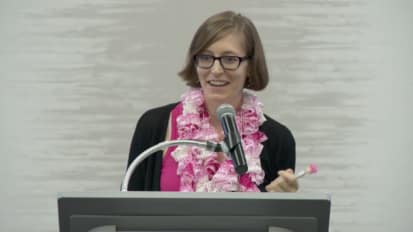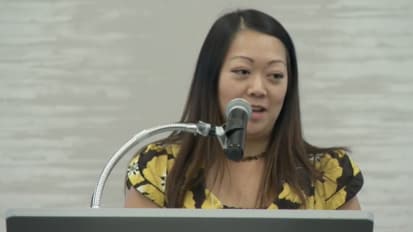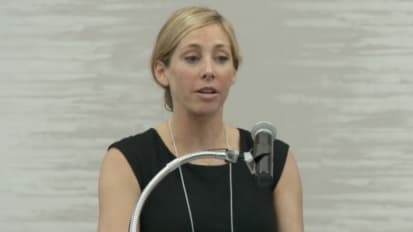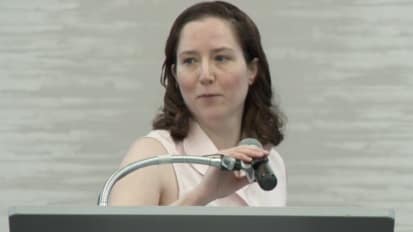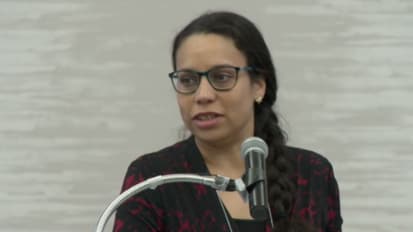Chapters
Transcript
MARISSA HOWARD-MCNATT: So I'm a surgeon, so I figured this time we'd talk about some of our basic surgical principles, lumpectomy and mastectomy. So one thing I wanted to start with is what I like, surgical history. So we'll go back in time and see how they treated breast cancer in the past. In the past, they really didn't know what to do with it-- we're talk talking the 1500s.
Ambroise Pare, who talked about local agents put on the breast and Versalius who knew more about circulation. But he talked about actually excising areas in the breast. And then Lorenz Heister talked about resection and he even removed muscle in the ribs. And James Syne talked about wide excision. He actually added something we know is important, which is removing the lymph nodes.
But really, breast cancer treatment, the grandfather that we all think of in surgery, the grandfather of surgery, is Halsted. And Halsted came in the era when general anesthesia had started and he came up with the radical mastectomy. It truly changed everything. And this really was the standard of care from the 1890s to the 1970s. I mean, it was the standard of care for a long time.
His theory is that breast cancer started in the breast and it spread locally to the muscle and the regional nodes, then someplace else. It was a very systematic process and it spread, and that's what he thought of it as. So the radical mastectomy, I'm going to show pictures. I know Dr. [INAUDIBLE] says she doesn't want to show pictures, but I love pictures and I'm a surgeon and so we're going to show anatomy pictures. We're going to bring you all back to the anatomy lab.
So this is an old drawing. And radical mastectomy included removing the breast, but also the pectoralis muscle the breast sits on, all the lymph nodes, and actually includes-- and you can see a little bit in this photo-- but he usually removed the cervical nodes, superclav and cervical nodes. So he really did a lot of resection in his patients. And this was the standard of care. It's aggressive treatment by today's standards definitely.
It did not always significantly improve survival rate. I mean, there are people who survived this surgery and did well, but not everybody survived. It had a high incidence of morbidity, lymphedema obviously, arm paralysis. But it was all we had. I know in the book, The Emperor of All Maladies. It's, of course, written by a medical oncologist, but he belies this surgery. It's like, well, that's all people had and it did save people's lives. It's all people had until the advent of chemotherapy and Tamoxifen, which was really first.
So then came along in the '70s, another paradigm shifter in breast cancer treatment, and that's Dr. Bernard Fisher with NSABP. So we heard Dr. Mamonis earlier, he's one of the really big people in NSABP and RG. But Dr. Fisher is really one of the first. And his paradigm treating cancer was different. It was more the biology of the disease, kind of what we understand now.
And one of the first studies he did was B04. As you know, studies start with numbers and so this was a very early study. And it randomized people who were clinically node negative, so you examine and you don't feel any lymph nodes, versus people when you examine and you feel [INAUDIBLE] lymph nodes are clinically node positive. And it randomized them to the radical mastectomy we saw, a total mastectomy, which really meant removing the breast and not the muscle and then total mastectomy with radiation.
Actually, this study they didn't remove lymph nodes on total mastectomy, but this is how this study was done. So the NSABP B04 results are shown here. And it shows that people are distant-disease free survival and overall survival was the same, no matter what surgery they got. The thing that made the difference was the biology of the disease. So people who were node negative, no matter what surgery they received, they did equally well versus people who were node positive.
So node negative women all did the same, node positive all did the same. They had worse outcomes in distant-disease free survival and overall survival. So that brought about the advent of maybe we don't have to do the radical mastectomy, we can do the modified radical mastectomy. And modified radical mastectomy for a surgeon is what we do a lot of nowadays, is removing the breast but preserving the muscle. We don't take the pectoralis muscle, only in special occasions, and removing some sort of lymph nodes.
Modified radical really means that you would perform actually no dissection. So this is what it can look like afterwards. With the radical, it's really more concave and deformed on the chest wall. So the next study that looked at surgery types was the NAACP B06. And this study I quote to my patients when I talk to them about their choice to get a lumpectomy or a resectomy. I just quote them the study. I keep out one arm of the study because it will confuse picture.
But in the study, people with small tumors were stratified to either total mastectomy, a mastectomy and actually no dissection; lumpectomy and actually dissection; or lumpectomy actually dissection and radiation. And this study is important because it includes this one arm without radiation that kind of comes into play a little bit in future studies that happen later on. But basically, they enrolled 1,200 patients.
Local recurrence was approximately 10% in the mastectomy group, 3% in the lumpectomy and radiation, and 9% with lumpectomy alone. And basically, again, it showed that there was no difference in the disease-free survival. So looking at all these women and looking at the three different types of surgical treatments, peoples' disease-free survival, distant disease-free survival, and overall survival is the same. So basically I tell my patients it doesn't matter if you have a lumpectomy or mastectomy, your overall survival is going to be the same.
No one surgery in this stage when this was performed was particularly better than the other one. So this kind of brought about the age where people could have a lumpectomy and that became more popular in the '80s, '90s, and today. So again, and the B06 results looking at that one arm, they had people who received radiation and people who did not receive radiation. If you received radiation, your chance of recurrence was lower. So that's why we include radiation for patients with lumpectomy.
And Dr. [INAUDIBLE] touched a little bit on this, but that's why people who have a lumpectomy receive radiation. So now the majority of women with early stage breast cancer usually choose to have a lumpectomy or him a mastectomy. So we're going to go into each one kind of individually and look at them more closely. So we're just getting look at mastectomy first.
So mastectomy is an option for people with a large tumor, meaning the tumors is big, and people with a family history, patients who do not want to have radiation. Because if you have a lumpectomy, you've got to radiation so some people have this fear of radiation. So if they have this fear and they don't want to do it, they're going to have to do a mastectomy. Or a patient that prefers it, just wants to have a mastectomy. Some women just want to have that.
Nowadays, we can form skin-sparing mastectomy. So all of our mastectomy patients, at some point we will offer them some kind of breast reconstruction either immediately or later on, after let's say radiation. And they have good cosmetic outcomes. So these pictures are all from more plastic surgeons at Wake Forest. So a skin-sparing mastectomy is where we spare the skin, make a small incision, and a lot of times we just remove the nipple-aeolar complex and do our surgery through that small incision.
It preserves the skin and it's really mainly used for when people are getting immediate reconstruction because I spare all the skin and basically, the plastic surgeon fills in that deficit to recreate the breast mound. But when you have this, you don't have a nipple and an areola on that side. And recently, probably the last five or so years, across the country there has been this more trend for what's called nipple-sparing mastectomy, where you save the nipple and the nipple and areola complex and keep that intact.
And the initial questions were, is it safe, can you do that, are you leaving tissue behind that later on might become cancer, will the nipple live because we're taking all the blood supply out of the nipple right underneath it and it's relying on these perforators that are farther away, and what does it look like aesthetically because we're doing plastic surgeons so they always like to do the aesthetics. So here are some operative pictures of different types of incisions. And people kind of go back and forth, if you spare the nipple, where would you put this incision?
Some people put them out laterally or over here. We tend to do a lot of this one where you kind of just go above it and it actually looks really good in the end. And it's honestly easier for me to do this incision than maybe one of these lower ones because then you have this big flap you have to work with and you're kind of operating in a cave, which can be a little more difficult. It still can be done, but this incision actually works really pretty good in our hands here.
So we've concluded that nipple-sparing mastectomies are safe, and especially you can also do this in women who are undergoing risk reduction surgery. So those women who are known BRCA carriers who want bilateral mastectomies, you can definitely do this. It all depends on the surgeon who is operating on you. But in our hands here, we are able to remove all tissue and women having a nipple-sparing mastectomy will not increase their risk of having cancer later on. And it's all about selection.
Again, nipple-sparing mastectomies are only for patients who really have a B or C cup breast. Ladies with larger breasts, it just won't look right on them. So I'd be remiss talking about mastectomy without mentioning contralateral prophylactic mastectomy because that's become the trendy thing to do over the past seven or so years. So Tuttle in Minnesota looked at this and from '98 to about 2005 and now even on, the trend has been rapidly increasing of contralateral prophylactic mastectomy, or removing the other breast, if you one breast has cancer in it.
And we've looked at here and other places have looked at why are women choosing this, and usually what we've found they were younger in age; usually they are white; usually they are college educated; they have insurance; and they have a family history of breast cancer. So there might be some women at higher risk because of family history, but they usually test negative for any kind of known genetic mutation. There might be other treatment factors.
One is BRCA testing, the mere fact that we thought that they had a family history, we tested them. Now some people get really anxious. Even though they've tested negative for the BRCA gene, they will go ahead and still want this. Some studies have looked at preoperative use of use of breast MRI and centers have shown that using breast MRI because maybe an MRI they might identify another lesion on the opposite breast and at least another biopsy, and that may or may not show cancer-- most times it doesn't. But people get really anxious and say, I don't want anymore of this, just perform a bilateral mastectomy.
A third reason why, also, is our plastic surgeons are just great. I mean, their reconstructive options and how they work and they get great outcomes. So some people are just, like, I just want 20-year-old breasts because that's what the plastic surgeon can give you. And it's this facility. Some people come to us or other tertiary care facilities because they know we have all these options for them and then they will tend to get to what we can offer.
And there is improved mastectomies and reconstructive techniques, and Dr. [INAUDIBLE] talked about this with implant based reconstruction or even with a flap reconstruction, our reconstructive options look great. I mean, people end up looking really good after their reconstructions. One of the other big reasons I think people are choosing more contralateral prophylactic mastectomies is they're overestimating their risk. And we can't ask people this.
And one is kind of what one of our other speakers has talked about, this fear of recurrence. So the fear recurrence is a great driver. A majority of patients will say, I want my other breast off because I'm afraid it's going to come back in the other breast and peace of mind. Most providers of breast cancer patients, we're not worried about so much fearing recurrence in the other breast, I'm worried about recurrence in your bones liver and that's more difficult to take care of. But it's hard for a patient to kind of wrap their minds around that and they're always worried about the other breast.
And recent studies show that, again, the most common cause is fear. And we've find that breast cancer patients overestimated their risk of developing contralateral breast cancer. So what is their actual risk? And I want to include this so you all can tell your patients. If someone has estrogen receptor positive breast cancer, treated with Tamoxifen, there's only about an 0.4% chance of recurrence in the other breast. If they are ER negative, it's about 5.5%, and all groups it's less than 0.7%.
So the 10-year risk of an ER positive person is about 4% to 5%. And in the ATAC trial, one of the trials that looked at aromatase inhibitors in post-menopausal women, the actual incidence was 3.2%. So it is very, very low. So when you tell your patients-- and I always tell my patients this who really come in saying, I want bilateral mastectomies-- I kind of try to pull them back from the ledge and start charging them and saying, look, you're chance of recurrence in the other breast is very low.
You really don't have to remove the other breast. The only people we talk more seriously about doing are people who are known mutation carriers, but most people aren't. So it's a long discussion with patients, but hopefully we can educate people more about this. So on the other hand, we have the choice of the lumpectomy. So a lumpectomy, as you all know, is just removing the tumor and preserving the breast and removing from surrounding tissue. So with a lumpectomy, the surgeon must try to establish a clear margin and if the tissue does not have a clear margin, meaning when we remove the specimen, if there is a tumor right on the edge, then it will necessitate another trip to the operating room to take out additional tissue.
As we talked about patients who have a lumpectomy, the majority will need radiation therapy. So one thing I want to talk about is margin width because it's been recently in the news, but it's more in the surgical literature that's come out recently. So margin width is assessed by the pathologist. We give the specimen to the pathologist. They ink the surface and try to tell whether the distance between the tumor and the cavity.
So a negative margin is no ink on the edge or on the cells of the edge. So margin sampling is always fraught with a lot of I'll call it semi danger. But it's very difficult because if you have a breast cancer that is [INAUDIBLE] like this, as you can see, if we perform a lumpectomy, these margins are not clear tumor. That's a positive margin and it may not be completely clear if you do a bigger size. Sometimes it can be very hard to access, even though interoperably we do the best we can, especially with radiographing the specimen and maybe using different devices in the operating room.
So surgeons and radiation oncologists disagreed in the past a lot about what was the best margin width. And this debate has been on for years. If you ask a surgeon or radiation oncologist, and people did poll them, it went anywhere from no tumor on ink to a 2 millimeter or more margin, depending on where you were. As a result, re-excisions are very common. I remember when I was training as a fellow, we would take people back three, even four times and it was a lot of re-excisions.
But recently, the SSO, the Society of Surgical Oncology, and ASTRO, which is the [INAUDIBLE] Oncology Society, convened a multidisciplinary panel to look at guidelines about margins. So they examined the relationship between surgical margin width and ipsilateral tumor recurrence and developed guidelines for people with early stage breast cancer. So these are people stage I and II breast cancer. And the guidelines can be found in the "Annals of Surgical Oncology" and ASTRO has a publication, too.
So the panel used a meta-analysis looking at margin width and ipsilateral recurrence in more than 33 studies. It had 28,000 patients to provide evidence for this. So this is for invasive breast cancer. So for patients with invasive breast cancer, the evidence showed negative margins or no [INAUDIBLE] was the optimal margin to be used for a lumpectomy to reduce recurrence. So wider margins of no tumor ink, 1 millimeter, 2 millimeters, 1 centimeter were not necessary.
And because they made this guideline in the past couple of years, it really has changed the way you practice. And so we're taking less patients back to clear margins. So now if you see somebody with a 1 millimeter margin, we're fine with it. As long as there's no tumor on ink, then they really do not need to go back for additional surgery. So positive margin, again, was defined as ink on invasive cancer or DCIS are associated with at least a two-fold increase in ipsilateral tumor recurrence.
And they also discovered that this risk was not eliminated by the use of radiation boost, specific therapy, or the biology of the disease, i.e. if a tumor is triple negative or estrogen receptor positive. So this question, should unfavorable subtypes of cancer require wider margins? The answer is no. Again, unfavorable meaning triple negative or protein amplified. So no really good evidence suggesting that.
And should increase margin widths be considered for patients of a young age? So young age in this was less than 40. So young age is associated with increased ipsilateral breast tumor occurrence after a lumpectomy and increased local relapse in the chest wall after mastectomy and is more frequently associated with adverse biology and pathological features. Because these people have longer to live than a 70-year-old and a lot of times, younger women, as you know, can have more aggressive tumors, such as triple negative breast cancers.
But there was no evidence that increased margin width nullifies an increased risk of ipsilateral breast tumor recurrence in young patients. So you do not have to achieve a wider margin with a young patient. Then recently, just in the past summer actually, guidelines came out about DCIS. Because the paper report only addressed invasive cancer. So this one is sort of hot off the presses about what to do about DCIS. DCIS can be difficult because it has this tendency to have we call have skipped lesions.
It could have DCIS here, it could DCIS over there, and you don't really see the relationship to the area. And some people describe it as branches on a tree, it spreads out. So this was a more difficult one to determine what the optimal margin was. So the same panel convened and came up with these recommendations. They actually said for DCIS, you need to obtain a 2 millimeter margin as a standard for adequate treatment and then patients could undergo whole breast radiation.
And the 2 millimeter is because of this whole idea of these skipped lesions, making sure you didn't miss anything. And then clinical judgment should be used in determining the need for further surgery in patients with negative margins less than 2 millimeters. So what about that person with like a 1 millimeter margin? So they said you just have to decide on the patients, which margin it was. If it's a margin that was close to the skin or close to the muscle, I mean you can't go back and take that so it really should be individualized to the patient.
But really, the gold standard for DCIS is a 2 millimeter margin. And margins bigger than 2 millimeters did not reduce the risk of cancer recurring in the breasts of women with DCIS who were treated with lumpectomy and radiation. So now we know for DCIS, the consensus now has been a 2-millimeter margin. So we heard a little bit earlier this morning about neoadjuvant chemotherapy. I don't want to go into a lot, but it does play a role in lumpectomy and mastectomy, as we've heard.
It's the accepted modality for treating locally advanced breast cancer or people with larger tumors. And as we learned about earlier this morning, the NSABP B-18 and B-27 showed comparable rates of disease-free and overall survival in patient who underwent neoadjuvant chemotherapy. And the thing about neoadjuvant chemotherapy that surgeons like is it can convert somebody who would need a mastectomy because their tumor is so big compared to the breast ratio. I mean, I'm always looking at somebody and thinking, OK, can I take this tumor out and still leave their breast looking good?
And the patient may not be worried about that, but they might be worried about that five years from now and I don't want them to say, oh, Dr. Howard-McNatt just didn't do a good job on my breast. I don't want them to say that. I want them to say, it looks good, I don't see the scar, everything looks great. So that's what I'm looking at a patient-- and some patients you may not be able to get a good cosmetic result with a lumpectomy, they may need a mastectomy. But one way to do it is to give them the adjuvant chemotherapy and that really does help.
So these last two sides are two things about lumpectomy versus mastectomy that came out recently and it might be a little bit different look at them. So M.D. Anderson-- and both of these studies were presented last year at the San Antonio Breast Conference. So M.D. Anderson reported a study looking at the complication rate related to cost for a lumpectomy and mastectomy. So they compared lumpectomy with whole breast radiation and mastectomy.
Now, most of the mastectomy patients in this cohort did have some kind of breast reconstruction. And the complication related cost was $8,000 higher for mastectomy with reconstruction for younger women with private insurance and higher for older women with Medicare. So in their study, more people with mastectomies had more complications and it cost more. And it's something we all kind of know in the back of our mind because if these women are doing mastectomies and then having plastic surgeons come in, it definitely costs more.
Another very interesting study that came out of the same meeting and the same preliminary session was from the Netherlands, who maintains a big database of all the patients in their country, of 37,000 women with early stage breast cancer. And patients who received a lumpectomy were 21% more likely to be alive after 10 years than those who received a mastectomy in their cohort. And there was no difference of disease-free survival.
It was hard to tease out a little bit about why that happened in their group. It may be that the radiation was somehow beneficial, which some people might think, but this is what they saw in their group. And this is with a more modern cohort. So I think more studies are going to be done on this issue. And one last thing is that we recently looked at SEER Medicare data of 1,700 women who are older than 70 with early stage breast cancer. This was done by one of our fellows last year and one of our fellows in the audience now.
And basically, it showed that older women undergoing lumpectomies with radiation had a better cancer specific survival than those undergoing mastectomy. And the reason we explained in the paper was that these women usually have smaller tumors than the women who had a mastectomy, they were more likely to be node negative so the pathology of their disease was different than the women who had a mastectomy. But if we adjusted for co-morbidities, the survival was dependent on tumor factors, like I talked about how big the tumor was in size or lymph nodes.
So again, as time is going on, we'll see that biology of the disease plays a very major role in determining the first step of most people's treatment, their surgery. So in conclusions, there is more surgical options for women with breast cancer and it's really a discussion that the surgeon has with the patient to determine what suits them best, either a lumpectomy or a mastectomy, and what they expect and what they want of their outcomes. OK. Thank you.
[APPLAUSE]
Marissa Howard-McNatt, MD, FACS discusses her topic in 'Lumpectomy Vs. Mastectomy'.
Related Videos
